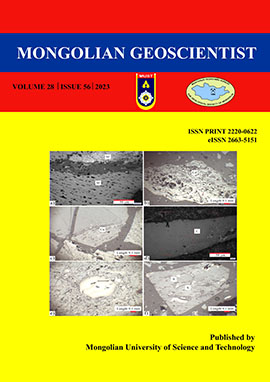Residual strain investigation of a polycrystalline quartzite rock sample using time-of-flight neutron diffraction
DOI:
https://doi.org/10.5564/mgs.v28i56.2451Keywords:
Time-of-flight (TOF) method, residual strain, Reitveld refinement, earthquakesAbstract
In this work, we studied the residual micro lattice strain of an onyx sample, which is a micro- to the cryptocrystalline variety of the mineral quartz SiO2. That the investigation has been carried out using in-situ stress experiments with the time-of-flight neutron diffraction method. The aim of the study is to investigate residual lattice strains and pressure directions in the sample using time-of-flight neutron diffraction, which is a powerful tool for the study of the residual strain behavior in bulk materials, like geological rock samples containing large grains. The residual strain was detected in different sample directions turning the sample in steps of 30° by 180° around the cylindrical z-axis. These experiments have been performed at the time-of-flight neutron strain diffractometer EPSILON, situated on the pulsed neutron source IBR-2M of the Joint Institute for Nuclear Research in Dubna, Russia. The results of this study will provide insights into the compressional and tensional residual strain of the crystallographic lattice planes, and will have implications for our understanding of the tectonic history of this region. These different strains are arranged in the sample by a sinusoidal distribution in radial directions.
Downloads
363
References
Calais, E., Vergnolle, M., San`kov, V., Lukhnev, A., Miroshnitchenko, A., Amarjargal, S., De`verche`re J. 2003. GPS measurements of crustal deformation in the Baikal-Mongolia area (1994-2002): Implications for current kinematics of Asia. Journal of Geophysical Research: Solid Earth, v. 108(B10), 2501, p. 14.1-14.13. https://doi.org/10.1029/2002JB002373
Cunningham, D. 2017. Folded Basinal Compartments of the Southern Mongolian Borderland: A Structural Archive of the Final Consolidation of the Central Asian Orogenic Belt. Geosciences, v. 7(1), p. 2-24. https://doi.org/10.3390/geosciences7010002
Friedman, M. 1972. Residual elastic strain in rocks. Tectonophysics, v. 15(4), p. 297-330. https://doi.org/10.1016/0040-1951(72)90093-5
Frischbutter, A., Neov, D., Scheffzük, Ch.,Vrána, M., Walther, K. 2000. Lattice strain measurements on sandstones under load using neutron diffraction. Journal of Structural Geology, v. 22(11-12), p. 1587-1600. https://doi.org/10.1016/S0191-8141(00)00110-3
Genyao, W., Yuan, W., Min, L. 2013. Palinspastic reconstruction and geological evolution of Jurassic basins in Mongolia and neighboring China. Journal of Palaeogeography, v. 2(3), p. 306-317.
Rietveld, H.M. 1967. Line profiles of neutron powder-diffraction peaks for structure refinement. Acta Crystallographica, v. 22(1), p. 151-152. https://doi.org/10.1107/S0365110X67000234
SchäFer, W. 2002. Neutron diffraction applied to geological texture and stress analysis. European Journal of Mineralogy, v. 14(2), p. 263-289. https://doi.org/10.1127/0935-1221/2002/0014-0263
Scheffzuek, Ch., Hempel, H., Frischbutter, A., Walter, K., Schilling, F.R. 2012. A device for sample rotation under external load for the simultaneous measurement of strain and orientation dependent material properties by means of TOF neutron diffraction. Journal of Physics Conference Series, v. 340(1), 012038, p. 1-6. https://doi.org/10.1088/1742-6596/340/1/012038
Scheffzuek, Ch., Ullemeyer, K., Vasin, R., Naumann, R., Schilling, F.R. 2014. Strain and Texture Investigations by Means of Neutron Time-of-Flight Diffraction: Application to Polyphase Gneisses. Material Science Forum, v. 777, p. 136-141. https://doi.org/10.4028/www.scientific.net/MSF.777.136
Scheffzük, Ch., Müller, B., Breuer, S., Badmaarag, A., Schilling, F.R. 2016. Applied strain investigation on sandstone samples using neutron time-of-flight diffraction at the strain diffractometer EPSILON, IBR-2M Dubna. Mongolian Journal of Physics, v. 2, p. 433-441.
Schlupp, A., Cisternas, A. 2007. Source history of the 1905 great Mongolian earthquakes (Tsetserleg, Bolnay). Geophysical Journal International, v. 169(3), p. 1115-1131. https://doi.org/10.1111/j.1365-246X.2007.03323.x
Taran, Y.V., Balagurov, A.M., Sabirov, B., Davydov, V., Venter, A. 2014. Neutron Diffraction Investigation of Residual Stresses Induced in Niobium-Steel Bilayer Pipe Manufactured by Explosive Welding. Materials Science Forum, v. 768-769, p. 697-704. https://doi.org/10.4028/www.scientific.net/MSF.768-769.697
Wenk, H.-R., Lutterotti, L., Vogel, S.C. 2010. Rietveld texture analysis from TOF neutron diffraction data. Powder Diffraction 25 (3), p. 283-296. https://doi.org/10.1154/1.3479004
Windley, B., Xiao, W. 2018. Ridge subduction and slab windows in the Central Asian Orogenic Belt: Tectonic implications for the evolution of an accretionary orogen. Gondwana Research, v. 61, p. 73-87. https://doi.org/10.1016/j.gr.2018.05.003
Downloads
Published
How to Cite
Issue
Section
License
Copyright (c) 2022 Altangerel Badmaarag, Deleg Sangaa, Vadim V. Sikolenko, Lkhamsuren Enkhtur

This work is licensed under a Creative Commons Attribution 4.0 International License.
Copyright on any research article in the Mongolian Geoscientist is retained by the author(s).
The authors grant the Mongolian Geoscientist a license to publish the article and identify itself as the original publisher.

Articles in the Mongolian Geoscientist are Open Access articles published under a Creative Commons Attribution 4.0 International License CC BY.
This license permits use, distribution and reproduction in any medium, provided the original work is properly cited.








